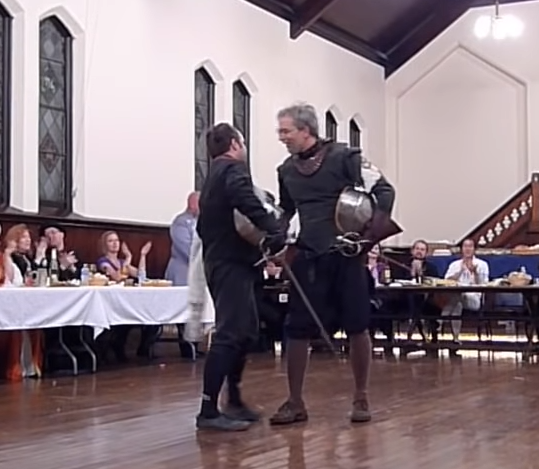Fencing John O’Meara – Strategy and Tactics
In mid-2011 I began training to face the Chicago Swordplay Guild’s John O’Meara. He’s explosively fast, tall, skilled, and he uses Fabris which is a very good book.
At this time the Italian rapier practitioners seemed unstoppable and successful examples of Spanish Fencing against high level Italian practitioners were rare. Certainly there wasn’t much on YouTube and the understanding when you fence at the WMAW gala is that within a day your fencing will be watched, scrutinized, and perhaps praised or criticized for years to come. It’s a high-pressure situation.
Knowing this was coming and knowing that we wanted to represent the tradition well I worked with and trained with my two friends and classical Italian Maestri, Eric Myers and Kevin Murakoshi. (Unknown to me John O’Meara had also been training and had worked with Charles Blair to train a local fencer of my height and relative fencing profile as best they could as an analog of what John would be fencing against.)
In secret, both of us trained against the other for 3 months. Friendships and memories are made from such as these.
In order to train we applied the True School Destreza tradition in its purest form; as a theoretical science to guide training. What are the causes that form John’s fight? What are the causes that form mine? Knowing these things can we form a training plan that will allow us to beat (or at least touch) an adversary with greater reach, a longer weapon, and a broader community in which train?
We broke John down into causes and patterns and then from these we created a training tree. (Which I have shared below.)
The fight is presented here:
Did we succeed? I’m not the person to answer that with any certainty but I think we demonstrated that someone practicing La Verdadera Destreza can compete well against a top level Italian fencer. It’s my hope that no viewer thinks I intend to represent all of the tradition and, if you view the tree below, you can see it’s an abbreviated subset of the tradition tuned for this adversary.
Is it perfect? Certainly not. Looking at it now I would have preferred my footwork to be more active and I would have hoped to have been aware enough of my surroundings to see the bit of ice that had fallen off the table which created a slippery surface. It’s too much of a burden for any one person to present themselves as the sole representation of the tradition and it’s not something I would try to claim. It was fencing within its time and I see both good and bad, but it served its purpose in that moment.
With love and affection for my friend John, I share this advice on how to fence against him (and perhaps many other Italians as well)
John O’Meara vs. Puck Curtis – Decision Tree
Inside Line
- Atajo Inside
- Adversary does nothing
- Attack with half reverse, transverse right, and Atajo again
- Or attack by thrust with transverse left
- Adversary attacks by disengagement
- Convert the adversary’s attack into a Line in cross with transverse right
- Or place an Atajo on the outside
- Adversary uses movement of increase to attempt to take Atajo inside
- Yield into circular reverse with a movement of conclusion and footwork left
- Adversary does nothing
- Invite with the Right Angle on the Inside
- Adversary attacks with engagement
- Yield into circular reverse with a movement of conclusion and footwork left
- Adversary attacks without engagement
- Place an Atajo over the attack
- Use a circular reverse (like a Narrowing) to pick up the attack while stepping left (either counterattacking or just attacking the adversary’s weapon)
- Adversary attacks with engagement
Outside Line
- Atajo Outside
- Adversary does nothing
- Attack with half cut, transverse left, and Atajo again
- Or attack by thrust by glide
- Adversary attacks by disengagement
- Convert the adversary’s attack with narrowing and transverse left
- Or place an Atajo on the inside
- Adversary uses movement of increase to attempt to take Atajo outside
- Yield into circular cut with a movement of conclusion and footwork right
- Adversary does nothing
- Invite with the Right Angle on the Outside
- Adversary attacks with engagement
- Yield into circular cut with a movement of conclusion and footwork right
- Adversary attacks without engagement
- Place an Atajo over the attack
- Use a circular reverse (like a Narrowing) to pick up the attack while stepping left (either counterattacking or just attacking the adversary’s weapon)
- Adversary attacks with engagement


